What is Epithelium?
Ø Epithelium is a tissue system in animals.
Ø Epithelium constitutes the outer layer of body surfaces, linings of the alimentary canal and the walls of hollow structures.
Ø It covers the internal or external surfaces of the body.
Ø Epithelial cells are held together by carbohydrate based cementing materials.
Ø They also possess special junctions between the cells.
Ø The bottom layer of epithelium is rest on the basement membrane.
Ø The basement membrane composed of a network of fibrous proteins particularly rich in collagens.
Ø Epithelial layers are NOT provided with any blood vessels.
Ø The cells of the epithelium obtain nutrients and oxygen by diffusion from the lymphatic vessels.
Ø Nerve endings occur in the epithelial tissues for receiving stimuli.
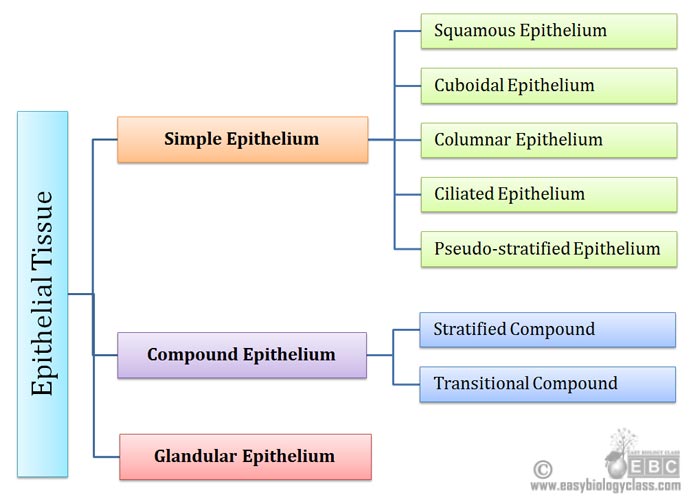
What are the Functions of Epithelial Tissue?
Ø Epithelium provides protection to the underlying structures.
Ø Protect organs from injuries by external agencies or pressure.
Ø Prevent infection by microorganisms.
You may also like NOTES in...
BOTANY BIOCHEMISTRY MOL. BIOLOGY
ZOOLOGY MICROBIOLOGY BIOSTATISTICS
ECOLOGY IMMUNOLOGY BIOTECHNOLOGY
GENETICS EMBRYOLOGY PHYSIOLOGY
EVOLUTION BIOPHYSICS BIOINFORMATICS
Ø Over-stressed epithelium becomes thick and keratinized.
Ø Outer cells of the epithelium quickly fall off due to high friction.
Ø In order to overcome the fall off cells, epithelial cells show rapid cell division rate.
Ø Epithelial surface may be absorptive, secretory or excretory in function.
Ø They may contain sensory cells or nerve endings for the reception of stimuli.
Ø All glands are made of epithelial cells.
Classification of Epithelial Tissue
Ø The classification of epithelial tissue is based on three criterions: (1) Number of cell layers, (2) Shape of individual cells and (3) Secretion or cell type.
Ø The outline of classification of epithelial tissue is given below (also in the figure above):
(I). Simple Epithelium
(II). Compound Epithelium
(III). Glandular Epithelium
(I). Simple Epithelium
Ø Simple type and composed of single layer of cells.
Ø Every cell in the epithelial layer connects to the basement membrane.
Ø Five types of simple epithelial tissue occurs in animals:
(1). Squamous epithelium
(2). Cuboidal (cubical) epithelium
(3). Columnar epithelium
(4). Ciliated epithelium
(5). Pseudo-stratified epithelium
 (1). Squamous Epithelium
(1). Squamous Epithelium
Ø They are flattened one layer thick epithelium.
Ø Cells are very thin (thinner than the width of the nucleus).
Ø The edges of the cells squamous epithelium are irregular and clear.
Ø Special junctions occur between cells of squamous epithelium.
Ø These junctions help to bind the cell firmly to form the layer.
Ø Squamous epithelium is mainly occurs in the renal capsules of kidney, alveoli of lungs and the wall of blood capillaries.
Ø The thin nature of squamous epithelium permits rapid diffusion of materials through the cells.
Ø The squamous epithelium of the blood vessels is called endothelium.
Ø The smooth appearance of squamous epithelium in the blood vessels and heart chamber wall allow relatively friction less flow of blood through them.
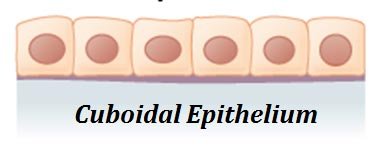 (2). Cuboidal Epithelium:
(2). Cuboidal Epithelium:
Ø They are less specialized type of epithelium.
Ø The cells cuboidal epithelium is cube shaped with a central nucleus.
Ø Cells are larger and thicker than that of the squamous epithelium.
Ø Cells are pentagonal or hexagonal in outline in the surface view.
Ø The cuboidal epithelium may be secretory or non-secretory.
Ø Cuboidal epithelium forms the lining of many ducts such as salivary ducts, pancreatic ducts and ducts of kidney.
Ø Secretory cuboidal epithelium is found in the salivary gland, sweat gland and thyroid.
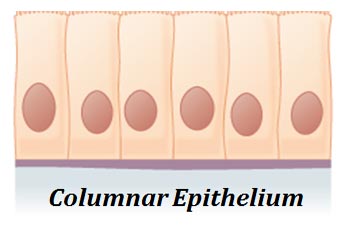 (3). Columnar Epithelium
(3). Columnar Epithelium
Ø In columnar epithelium, the cells are taller and narrow in outline.
Ø They possess more cytoplasm per unit area.
Ø Each cell possesses a nucleus which is located at the base of the cells.
Ø The side of the epithelial cells facing to the organ cavity possesses brush borders of microvilli.
Ø The microvilli increase the surface area for the absorption.
Ø In the columnar epithelial cells of stomach, some cells are modified into goblet cells.
Ø The goblet cells secrete large amount of mucus
Ø Mucus protects the stomach epithelium from the high acidic pH and also from the digestive enzymes.
Ø Occurrence of columnar epithelium: lining of stomach, lining of small intestine, kidney duct and in thyroid gland.
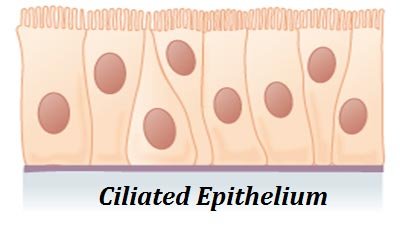 (4). Ciliated Epithelium:
(4). Ciliated Epithelium:
Ø Here the cells are columnar (similar to columnar epithelium).
Ø The cells of the ciliate epithelium possess many cilia at their free surface.
Ø They are always associated with mucous secreting goblet cells.
Ø Mucus produces the fluid in which the cilia can setup currents.
Ø Occurrence and functions of ciliated epithelium:
$ Inside the oviduct the ciliated epithelium helps in the movement of ovum
$ Ciliated epithelium occurs in the spinal canal.
$ Respiratory passages such trachea, bronchi and bronchioles possess ciliated epithelium. The mucus can trap bacteria and other infective particles and protect it from reaching the lungs.
(5). Pseudo-stratified Epithelium
Ø In the sectional view, the pseudo-stratified epithelium appear as stratified (many layered or irregular layered).
Ø The appearance is due the difference in the size of the cells constituting the epithelia and NOT due the presence of many layers of cells.
Ø Here some cells in this epithelium do not reach up to the free surface.
Ø Occurrence: pseudo-stratified epithelium is present in the lining of urinary tract and respiratory passages.
(II). Compound Epithelium
Ø Compound epithelium consists of more than one layer of cells.
Ø Compound epithelium is thicker than simple epithelium.
Ø Two types of compound epithelium occur in animals.
(1). Stratified Compound Epithelium
(2). Transitional Compound Epithelium
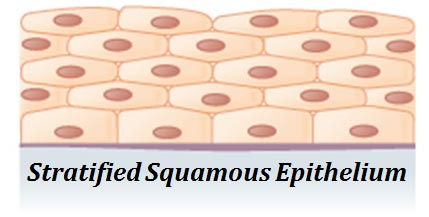 (1). Stratified compound epithelium
(1). Stratified compound epithelium
Ø It is a compound epithelium formed of many types of cells.
Ø Stratified compound epithelium is thicker than simple epithelium.
Ø They form tough impervious barriers/boundaries.
Ø Many layers of cells in the compound epithelium are formed by the mitotic cell division of the germinal layer.
Ø The germinal layer is rest over the basement membrane.
Ø First formed cells are cuboids and they pushed upward by the subsequent divisions of the cells.
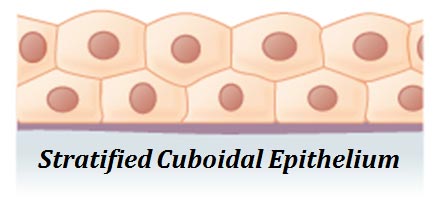 Ø When the cell pushed upward, they become flattened.
Ø When the cell pushed upward, they become flattened.
Ø This condition of cells is called squames.
Ø Squames of stratified epithelium occurs in the esophagus.
Ø In esophagus, the squames protect the underlying tissue against the mechanical damages by the friction of swallowed food.
Ø In some area the stratified epithelium is transformed into dead horny layers.
Ø This layer is eventually become keratinized and flakes away.
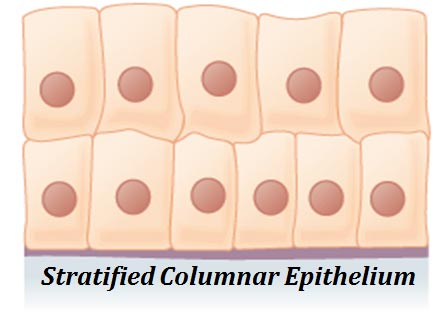 Ø This type of keratinized epithelium is called cornified epithelium.
Ø This type of keratinized epithelium is called cornified epithelium.
Ø Cornified stratified epithelium is found on the external surface of the skin.
Ø They also occur in the buccal cavity and virginal wall.
Ø Based on the shape of the cells which constitute the stratified epithelium, it may be of different types:
$ Stratified squames epithelium found in the esophagus
$ Stratified cuboidal epithelium found in the sweat gland ducts
$ Stratified columnar epithelium seen in the mammary gland ducts
| You may also like... | ||
|---|---|---|
| NOTES | QUESTION BANK | COMPETITIVE EXAMS. |
| PPTs | UNIVERSITY EXAMS | DIFFERENCE BETWEEN.. |
| MCQs | PLUS ONE BIOLOGY | NEWS & JOBS |
| MOCK TESTS | PLUS TWO BIOLOGY | PRACTICAL |
(2). Transitional Compound Epithelium
Ø It is a modified stratified compound epithelium.
Ø They composed of 3 to 4 layers of cells of similar size and shape.
Ø In the free surface, the cells of this epithelium are more flattened.
Ø Here the surface cells do not fall off easily.
Ø The cells of transitional compound epithelium can modify or change their size and shape when required.
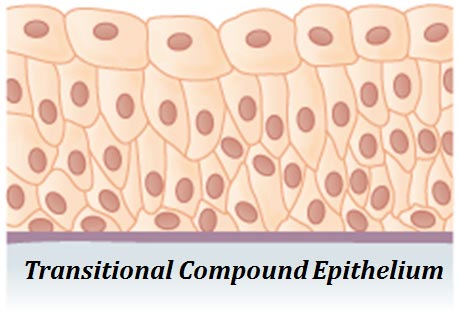 Ø This type of epithelium occurs in organs which are subjected to high stretching.
Ø This type of epithelium occurs in organs which are subjected to high stretching.
Ø Example: bladder, uterus and the pelvic region of the kidney.
Ø The thickness of this tissue prevents the escape of urine to the surrounding tissues.
(III). Glandular Epithelium
Ø They are usually not considered as a separate class of epithelial tissue.
Ø They occur in both simple and compound epithelium.
Ø Here, some of the cells of the tissue will be glandular or secretory.
Ø Example: Mucous membrane
Ø An epithelium containing many goblet cells is called mucous membrane.
Ciliated Epithelium (Source CC Wikipedia)

Squamous Epithelium (source CC Wikipedia)
Transitional Compound Epithelium (source CC Wikipedia)
Key questions:
- Types of epithelial tissue and functions?
- What are the functions of epithelium?
- What is simple squamous epithelium?
- What is simple cuboidal epithelium?
- What are the functions of squamous epithelial cells?
- Differentiate stratified cuboidal and stratified squamous epithelium.
- What is pseudo-stratified epithelium?
- What is transitional epithelium?
- Give examples of epithelial tissue

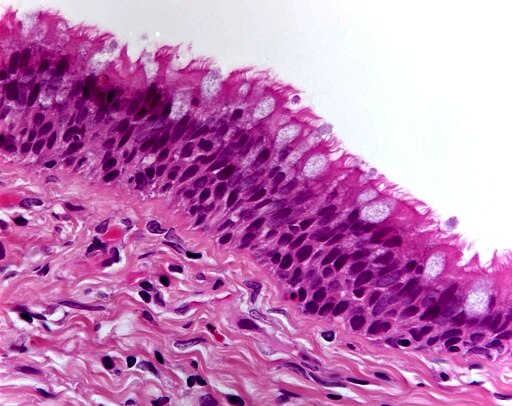

not bad !!!!!